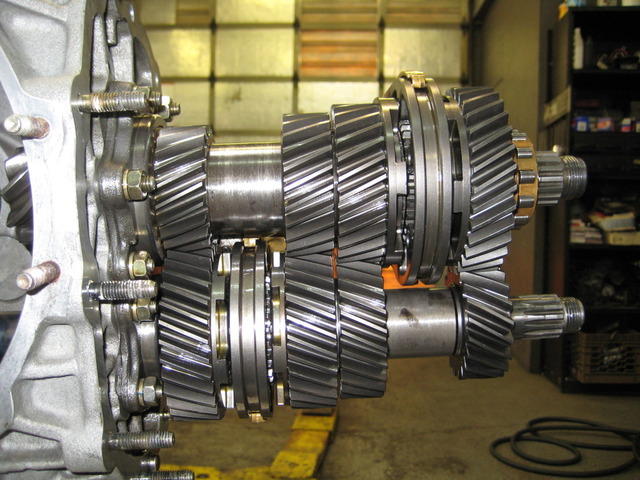Weismann Transmissions

Does anyone have any pictures showing the insides of the old FTA? I’d like to see the gears. Carroll Smith mentioned in one of his books that the basic differences between the two brands [Hewland and Weismann] are that Weismann does all of his shifting on the intermediate shaft rather than on the pinion shaft, and that this considerably reduces the inertial forces involved, makes the shift notably quicker and increases the life span of the engaging dogs by a notable margin.
I am curious because if you look at the following picture of a 930 of which the gears from left to right are 4-3-2-1, the shift between 4<SUP>th</SUP>/3<SUP>rd</SUP> is on the intermediate shaft (driving shaft) and the shift between 2<SUP>nd</SUP>/1<SUP>st</SUP> is on the pinion shaft (driven shaft). The reason for that is because the 4<SUP>th</SUP>/3<SUP>rd</SUP> gear ratios are overdrive - i.e. the small gears are on the pinion shaft and are too small for engagement dog rings, hence on the intermediate shaft.

Driving : Driven
Small gear : Large gear = normal drive (e.g. 16:36 or 26:27)
Large gear : Small gear = over drive (e.g. 27:26 or 31:22)
If all of Weismann shifts are on the intermediate shaft, does this mean all the gear ratios are overdrive with a funny CWP ratio? If not, how were the dog rings fitted in? :huh:
Second question:-
What are the pros and cons of overdrive gear ratios? I thought they were for economy driving but apparently Porsche 930 and also racing 962 used overdrive as tall as 0.7 and 0.61. Please enlighten me.
Thanks in advance.

Does anyone have any pictures showing the insides of the old FTA? I’d like to see the gears. Carroll Smith mentioned in one of his books that the basic differences between the two brands [Hewland and Weismann] are that Weismann does all of his shifting on the intermediate shaft rather than on the pinion shaft, and that this considerably reduces the inertial forces involved, makes the shift notably quicker and increases the life span of the engaging dogs by a notable margin.
I am curious because if you look at the following picture of a 930 of which the gears from left to right are 4-3-2-1, the shift between 4<SUP>th</SUP>/3<SUP>rd</SUP> is on the intermediate shaft (driving shaft) and the shift between 2<SUP>nd</SUP>/1<SUP>st</SUP> is on the pinion shaft (driven shaft). The reason for that is because the 4<SUP>th</SUP>/3<SUP>rd</SUP> gear ratios are overdrive - i.e. the small gears are on the pinion shaft and are too small for engagement dog rings, hence on the intermediate shaft.
Driving : Driven
Small gear : Large gear = normal drive (e.g. 16:36 or 26:27)
Large gear : Small gear = over drive (e.g. 27:26 or 31:22)
If all of Weismann shifts are on the intermediate shaft, does this mean all the gear ratios are overdrive with a funny CWP ratio? If not, how were the dog rings fitted in? :huh:
Second question:-
What are the pros and cons of overdrive gear ratios? I thought they were for economy driving but apparently Porsche 930 and also racing 962 used overdrive as tall as 0.7 and 0.61. Please enlighten me.
Thanks in advance.

